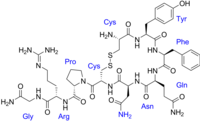
Photo from wikipedia
Background In septic shock, vasopressors aim to improve tissue perfusion and prevent persistent organ dysfunction, a characteristic of chronic critical illness (CCI). Adjunctive vasopressin is often used to decrease catecholamine… Click to show full abstract
Background In septic shock, vasopressors aim to improve tissue perfusion and prevent persistent organ dysfunction, a characteristic of chronic critical illness (CCI). Adjunctive vasopressin is often used to decrease catecholamine dosage, but the association of vasopressin response with subsequent patient outcomes is unclear. We hypothesized vasopressin response is associated with favorable clinical trajectory. Methods We included patients with septic shock receiving vasopressin as a catecholamine adjunct in this retrospective cohort study. We defined vasopressin response as a lowering of the catecholamine dose required to maintain mean arterial pressure ≥65 mm Hg, 6 h after vasopressin initiation. Clinical trajectories were adjudicated as early death (ED; death before day 14), CCI (ICU stay ≥14 days with persistent organ dysfunction), or rapid recovery (RR; not meeting ED or CCI criteria). Trajectories were placed on an ordinal scale with ED the worst outcome, CCI next, and RR the best outcome. The association of vasopressin response with clinical trajectory was assessed with multivariable ordinal logistic regression. Results In total 938 patients were included; 426 (45.4%) were vasopressin responders. The most frequent trajectory was ED (49.8%), 29.7% developed CCI, and 20.5% had rapid recovery. In survivors to ICU day 14 (those without ED), 59.2% had CCI and 40.8% experienced RR. Compared with vasopressin non-responders, vasopressin responders less frequently experienced ED (42.5% vs. 55.9%) and more frequently experienced RR (24.6% vs. 17.0%; P < 0.01). After controlling for confounders, vasopressin response was independently associated with higher odds of developing a better clinical trajectory (OR 1.63; 95% CI 1.26−2.10). Medical patients most frequently developed ED and survivors more commonly developed CCI than RR; surgical patients developed the three trajectories with similar frequency (P < 0.01). Conclusions Vasopressin responsive status was associated with improved clinical trajectory in septic shock patients. Early vasopressin response is a potential novel prognostic marker for short-term clinical trajectory.
Journal Title: Journal of Intensive Care Medicine
Year Published: 2022
Link to full text (if available)
Share on Social Media: Sign Up to like & get
recommendations!